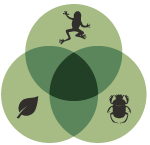Despite the growing number of research regarding the Colombian tropical dry forest and some efforts to collect biological records of its species, it is not yet possible to establish maps of species distributions for this ecosystem. Therefore, systematic sampling of different biological groups is needed and nationwide data should be consolidated in order to prioritize conservation areas.
The Tropical Dry Forest (TDF) is a prioritized ecosystem for the conservation of Colombian diversity and biological uniqueness. The incipient knowledge about TDFs, in addition to their proximity to urban centers and historic tendency of transformation to productive systems, has risked its species, ecological processes, and ecosystem services.
Up to the present, the limited access to information and the small number of nationwide data compilations about the TDF have impeded a detailed knowledge of species' distributions and richness 1. In recent years, the Humboldt Institute, in association with researchers from around the country, have compiled biological records of plants, amphibians, and dung beetles from TDFs (groups of species that indicate ecosystem conservation status1). Due to this collective effort that aims to study TDF diversity in greater detail, distribution maps of observed species richness were produced for each of the biological groups previously mentioned.
The maps show that the areas with higher observed species richness of plants are focused in the Caribbean (around 250 species/km2 in Magdalena and Atlántico) and also dung beetles, with approximately 39 species/km2. Amphibians had the highest observed species richness values in the complex of Barranquilla-Guajira, with 23 species/km2, with the ecological and geographic complexes of Barranquilla-Guajira and Bajo Caribe sheltering 57% of the species richness reported for the northern part of the country.
The areas of existing TDF house a high number of unique species, which are not found in other regions. This means that there is a high level of biodiversity with restricted distributions exclusive to each locality. However, the information that is currently available is not enough to identify the areas with greatest species richness and conservation priority with certainty. For example, excluding the reports about amphibians in the Catatumbo, the regions of the Llanos, Northern Andes, and the valley of the Patía River lack dung beetle and amphibian inventories. Such information gaps show the need of increasing sampling efforts in those areas without information.
The maps of species richness distributions are useful tools for making decisions regarding the conservation of a certain biological group. Summarized in such maps are the species records, which aid in prioritizing areas that need biological inventories. Nevertheless, research efforts about TDF ecology, functioning, and ecosystem importance should increase in order to guarantee the conservation of these forests.



